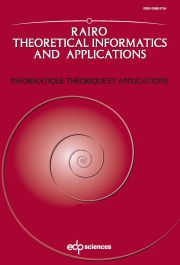Article contents
Number-Conserving Reversible Cellular Automata and Their Computation-Universality
Published online by Cambridge University Press: 15 April 2002
Abstract
We introduce a new model of cellular automaton called a one-dimensional number-conserving partitioned cellular automaton (NC-PCA). An NC-PCA is a system such that a state of a cell is represented by a triple of non-negative integers, and the total (i.e., sum) of integers over the configuration is conserved throughout its evolving (computing) process. It can be thought as a kind of modelization of the physical conservation law of mass (particles) or energy. We also define a reversible version of NC-PCA, and prove that a reversible NC-PCA is computation-universal. It is proved by showing that a reversible two-counter machine, which has been known to be universal, can be simulated by a reversible NC-PCA.
Information
- Type
- Research Article
- Information
- Copyright
- © EDP Sciences, 2001
References
- 7
- Cited by

